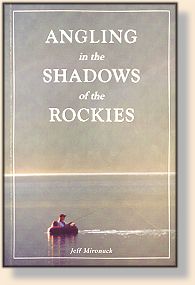Fishing the Lakes of the Kootenays
By Steve Harris
The town of Cranbrook has been my home for most of my thirty-five years.
After catching my first native trout at only eight, I've been hooked ever
since. The southeast corner of British Columbia is known commonly as the
East Kootenays. Being surrounded the Rocky Moutains and its captivating
scenery has made the outdoors my place of choice.
Lakes in the Kootenay are highly productive thanks to quality stocking programs
and tighter fishing regulations. The influx of fly fishers and catch and release has
helped the trout population and created better angling opportunities. There are
a vast number of lakes ranging from small pothole lakes to deep clear lakes
several miles long.
While winters can be quite harsh, most Kootenay lakes are ice-free by early May.
After spending at least five months under thick ice the trout are ready to feed on
insect life and challenge the fly fisher once again. As the water warms to above
seven degrees (Celsius) the first hatches start to show. The chironomids begin
their upward journey to hatch into adults to complete their cycle. The experienced
fly fisher with the right pattern can catch upward of thirty fish a day when the
trout are in a heavy feed. The chironomids are usually shades of black, brown and
green. Some of these can reach an incredible length of one inch though most are
usually about 1/4th of that size. Both floating and sinking lines are used to mimic
the upward motion the chironomid makes.
As the water warms even more and the days get longer you can expect
to see mayflies, damsels, dragons and even the caddis. The mayflies
generally hatch in the early afteernoons until dusk. Windy and overcast
days are great times to experience these hatches. If there is no visible
emergence of adults then nymphs below the surface should work. Best
patterns to try include Hare's Ear, Pheasant Tail or a small Halfback.
When adults are present Adam's or Cahill's should produce. Hook sizes
are 10 through 16. There are always those days when mayflies are
hatching as well as caddis. The adult caddis can really excite the trout
and if conditions are right it can make for a great dry fly fishing. The
Elk Hair Caddis, Mikuluk Sedge and Humpy work ideal. The large
Travelers sedge can be matched on a size 8 hook, while the common
caddis is generally about a size 14. Experiencing a caddis hatch at night
fall, when large trout are slashing at the surface, is pure enjoyment.
By the month of June the days are getting warmer and longer. This triggers
the migration of damsel and dragon nymphs towards the shore line. The
trout key in on these large nymphs in the reed beds and cattails. When
the fish are taking damsels, a sink-tip or a floating line is the ticket.
Damsel imitations are tan, shades of green or even bright yellow. Size
10 to 14 long shank make nice damsels when tied slender. Jack Shaw wrote
about the take on a damsel, "it can be as soft as a puff or wind or as vicious
as a snapping dog." This is all so true, I've missed many fish on light strikes,
yet had numerous break-offs from very strong ones.

The dragonfly nymphs are a much sought after food item by trout. In
late June or early July these nymphs can be seen walking the shoreline
and up tall blades of grass. This is the time to hook up with a slow,
full-sink line. They can be best represented with green, black or brown
patterns. My first experience with the dragon nymph happened several
years ago. While unloading my boat at Wapsi Lake, I noticed a large black
insect climbing a nearby log. As I looked closer in the surrounding grass
I found two or three more. These were migrating dragonflies and I hoped
the trout had keyed in on them. In a hurry my fly rod was set up and a
large nymph was tied to my tippet. To the left of the boat launch was a
large stand of cattails. There seemed to be a good number of fish
working that area so I rowed over and dropped anchor. I made a cast
right and with two strips of the line a nice rainbow of 3 pounds
intercepted my fly. The prime silver was released along with 13 - 14
others that afternoon. When the dragonfly nymphs are making their
journey towards the shoreline, the fishing can be exceptional. ~ Steve Harris
Concluded next time!
About Steve Harris:
Living in the Kootenays for most of his life has given Steve the
opportunity to perfect his stillwater skills on the many pristine lakes.
He is currently employed with the school board in Cranbrook and
guides part-time in the summer months. When not working as a guide,
Steve relaxes on one of his many favorite waters. Averaging well over
100 days on the water every year gives Steve a better understanding than
almost anyone of the East Kootenay lakes. He has become well known
for his willingness to teach others the art of stillwater fly fishing. You can
contact him at: (250) 489-3695.
Credits: From Angling in the Shadows of the Rockies
by Jeff Mironuck. We thank
Frank Amato Publications, Inc. for use permission!
Our Man In Canada Archives
|



